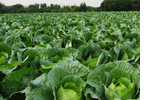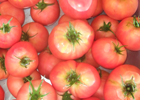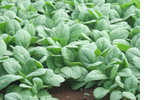Here's the text.
Vegetables from Yokohama
Last Updated August 24, 2022



- Agriculture in Yokohama is rich in a variety of vegetables, fruit trees, livestock, and flowers, but among them, vegetable production is the largest, accounting for about 70% of the area.
- Cabbage has the highest production volume, ranking 10th nationwide. (Produced in 2018.) Ranking out of about 1,800 municipalities nationwide.
- Vegetable production in the city is about 60,000 tons, equivalent to about 18% of Yokohama's vegetable consumption.
Seasonal fresh local vegetables can be purchased at agricultural direct sales outlets and at local vegetable corners at supermarkets.
As for the season of main vegetables produced in Yokohama, please see "Hamana-chan seasonal calendar (PDF: 769KB)".
Cabbage (seasonal season: spring and autumn)
![]()
Cabbage has many varieties and is a vegetable that can be eaten all year round.
The yield in Yokohama is about 13,000 tons (Note 1), ranking 10th (Note 2) compared to about 1,800 municipalities nationwide. Kanagawa Ward is particularly popular in the city and is sold under the name "Yokohama Cabbage".
In Yokohama, spring cabbage from May to June and winter cabbage from October to December are made, but spring cabbage and winter cabbage have different varieties. Therefore, it is natural that the cutting of the core is fresh, but spring cabbage (a loose round roll) is light and fluffy, and is suitable for salads. Winter cabbage (flat and hard winding) is better with leaves that feel heavier than the size, and is suitable for stewed dishes. When you buy cabbage, choose the one that suits each characteristic.
Cucumber (seasonal season: summer)
![]()
Cucumbers, a typical summer vegetable along with tomatoes and eggplants, are at their peak in June and July in Yokohama.
Cucumbers are grown in various parts of the city, but are produced in Totsuka Ward, Izumi Ward and Tsuzuki Ward .
Cucumbers are more than 95% of water and have little nutritional value, but they are indispensable to the dining table due to their refreshing flavor and freshness of the throat during hot days when appetite is low.
Potato (seasonal season: summer)
![]()
Potato cultivation in Yokohama has a long history, and has been cultivated for private use on the plateau in Mitsuzawa, former Hodogaya Ward (now Kanagawa Ward) since the Ansei period. Because it was a suitable place, the quality was good, and in the Taisho era, cultivation became so popular that seed potatoes were shipped throughout the Kanto region.
The yield is 2,130 tons (Note 1), and the new jaga will be lined up at farmers' direct sales outlets from June to July.
Tomato (seasonal season: summer)
![]()
Tomato, which is popular as a summer fruit vegetable, has the highest production volume in Yokohama City in Kanagawa Prefecture, and the yield is 4,040 tons (Note 1).
The season of tomatoes is summer, but house-grown tomatoes shipped in early spring have a lot of sunshine hours until harvest and become sweet and delicious.
Tomato is a healthy vegetable rich in vitamins, and it is said that "when tomatoes turn red, the doctor turns blue." In particular, vitamin C in tomatoes is not lost when processed strongly against heat.
Tomatoes are also popular products at direct sales outlets, and fresh tomatoes can be obtained in nearby direct places in Yokohama, where there are many direct sales outlets. Color your delicious and healthy dining table with bright red and fresh Yokohama tomatoes.
Eggplant (seasonal season: summer and autumn)
![]()
Eggplant is a summer vegetable with a long harvest time, and is harvested in Yokohama from the end of June to the end of October. There are various eggplants throughout Japan, such as elongated "long eggplant", round "Kamo eggplant", "rice eggplant", and small "small eggplant", but in Yokohama, many varieties called "Senryo 2" are made. Has been done.
In Yokohama, eggplants are cultivated about 45 hectares and 1,110 tons are harvested (Note 1).
Komatsuna (seasonal season: winter)
![]()
Komatsuna (Komatsuna) is a vegetable originating in Komatsugawa, Edogawa-ku, Tokyo, but according to the statistics of the Ministry of Agriculture, Forestry and Fisheries (Statistical Information Database of the Ministry of Agriculture, Forestry and Fisheries), Yokohama City surpassed Edogawa-ku, which had been the highest yield until then, in 2003. Was ranked first in Japan. The yield produced in 2006 was 3,700 tons, also the highest in Japan. It is mainly made in Tsuzuki Ward , Kohoku Ward and Totsuka Ward throughout the year.
Producers are striving to create safe and delicious komatsuna by introducing the latest technologies such as composting soil creation and "covering cultivation" to prevent damage to pests.
Komatsuna rich in various vitamins and minerals. Please enjoy it with various cooking methods such as boiled rice and boiled rice.
Spinach (seasonal season: winter)
![]()
In Yokohama, taking advantage of the proximity of consumption areas, leaf production that emphasizes freshness is thriving. The yield of spinach is 4,200 tons (Note 1), ranking 11th (Note 2) compared to about 1,800 municipalities nationwide.
In particular, the area of spinach is large in Tsuzuki Ward , accounting for about 40 percent of the total acreage of the city.
Producers are making efforts to reduce the use of pesticides as much as possible by introducing the latest technologies such as "covered cultivation" to prevent damage to pests. Spinach is rich in vitamin A, iron, folic acid, etc. By all means, please buy fresh Yokohama spinach.
Daikon radish (seasonal season: winter)
![]()
A typical winter vegetable, the yield of radish is 6,590 tons (Note 1).
Depending on the direct sales place, there are a wide variety of varieties, such as blue neck radish, Chuta, a friend of Miura radish suitable for oden, and spicy radish used for condiments. Choose a variety according to the application and taste each taste.
Taro (seasonal season: winter)
![]()
Taro is a vegetable that has been around in Japan for a long time, and was the mainstream of potatoes until the Edo period when sweet potatoes and potatoes came to Japan. It was among the top three vegetable productions in 1950, but has since been on a downward trend.
Taro is a lucky charm for the prosperity of descendants because of its many child and grandchild potatoes around the parent potato, and is used for New Year's cuisine.
Carrots (seasonal season: winter)
![]()
Carrots are root vegetables of green and yellow vegetables.
The yield of Yokohama City is 991 tons (Note 1), which is produced in Seya Ward. Most of the carrots we eat now are West carrots, and this West carrots were first brought to Yokohama and Nagasaki at the end of the Edo period when Japan opened.
The bright orange color is a pigment called carotene, which becomes vitamin A in the body. Because carotene is fat-soluble, stir-fry or fried food promotes absorption into the body. Carrot leaves contain more nutrients than the roots, are suitable for stir-fries and fried foods, and can be used as young leaves. Carrots with leaves are rarely placed in supermarkets, so be sure to purchase carrots with leaves at direct sales outlets.
Sources and Reference Materials
Note 1 Source: Kanagawa Agriculture, Forestry and Fisheries Statistics Association (2008) “Kanagawa Agriculture, Forestry and Fisheries Statistics Annual Report 2006-19 (2006-2007)”
Note 2 Source: Calculated by sorting the Ministry of Agriculture, Forestry and Fisheries "2006 crop condition survey (vegetables) data by municipalities". Statistics and Information Division, Policy Bureau General Affairs Department
[Reference Materials]
Number of farmers sold in Yokohama City in 2005 (2005) and acreage
"2005 Agriculture and Forestry Census" (Yokohama City Statistical Portal)
Regarding the number of farms sold in Yokohama City in 2010 (2010)
"2010 World Agriculture and Forestry Census" (Yokohama City Statistical Portal)
You may need a separate PDF reader to open a PDF file.
If you do not have it, you can download it free of charge from Adobe.
![]() To download Adobe Acrobat Reader DC
To download Adobe Acrobat Reader DC
Inquiries to this page
Agriculture Promotion Division, Agricultural Administration Department, Green Environment Bureau
Telephone: 045-671-2637
Telephone: 045-671-2637
Fax: 045-664-4425
Email address: mk-nogyoshinko@city.yokohama.lg.jp
Page ID: 668-255-814







